Japan: Engyōji Temple in Himeji, from Millennial Serenity to Cinema
- Olivier

- Aug 29, 2023
- 8 min read
Updated: Oct 29
Engyōji Temple (円教寺) is a Buddhist complex located on Mount Shosha in Himeji, Hyōgo Prefecture. Founded in 966, this temple has a rich and eventful history spanning over 1,000 years. Pilgrimage and cinema have greatly contributed to its recent popularity. Let's revisit the footsteps of "The Last Samurai".
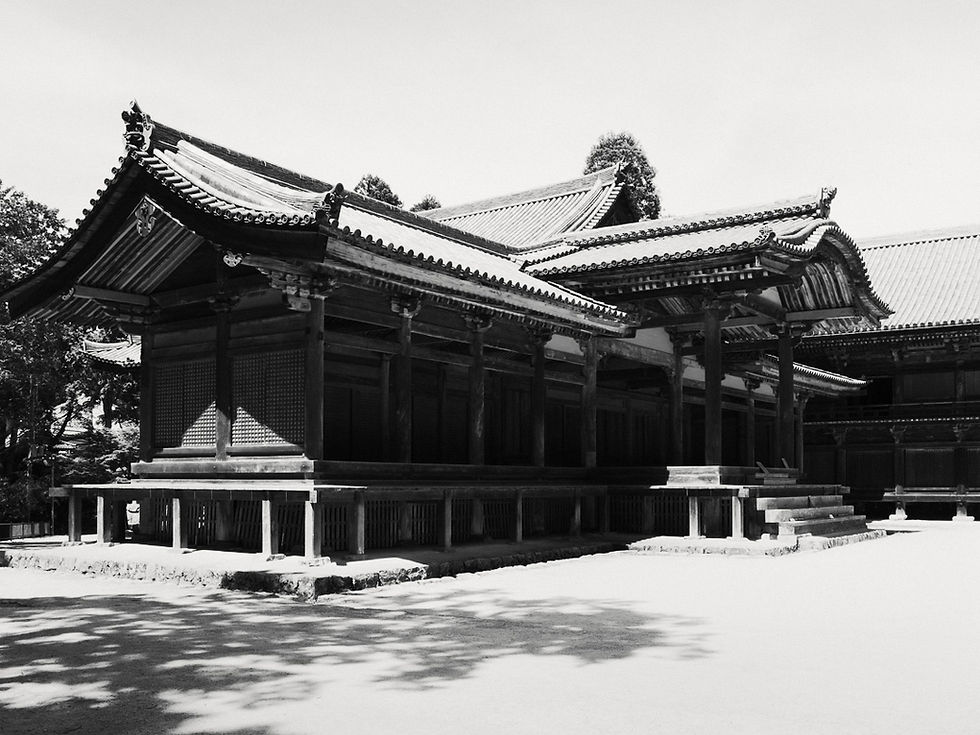
© O. Robert
Engyōji is a remarkable example of Japanese Buddhist architecture belonging to the Tendai sect. With its beautifully constructed wooden buildings, its preserved natural surroundings, and its spiritual significance, it stands as one of Japan's most beautiful temples and an inspiring location for any photographer.
Engyōji is also a recognized pilgrimage site. It is part of the Saigoku 33 Kannon Pilgrimage, a circuit of Buddhist temples dedicated to the goddess Kannon, the Bodhisattva of compassion.
Beyond its cultural, spiritual, and historical values, Engyōji has been extensively used as a set for international films, Japanese dramas, and commercials. The most famous example is the film "The Last Samurai" starring Tom Cruise and Ken Watanabe (see below).
Like any site of such importance, it has undergone major periods of prosperity, decline, and revival. Here is an overview of its evolution over the centuries.

© O. Robert
Origins, Development, Decline, and Revival of Engyōji
Heian Period
Engyōji Temple was founded in 966 by the monk Shōkū Shōnin (性空上人), a disciple of the renowned monk Ryōgen (912-985), who was the 18th abbot of Enryakuji Temple, the main center of the Tendai school, located on Mount Hiei near Kyoto. Shōkū, also known as "the saint of Himeji," is famous for seeking a place conducive to meditation and Buddhist teaching. According to legend, he chose Mount Shosha to establish Engyōji after experiencing a vision.
Heian to Muromachi Period
Under the influence of Shōkū Shōnin, Engyōji Temple became an important spiritual center, attracting many monks and practitioners. The temple quickly gained a strong reputation, and numerous buildings were constructed to support religious activities and the training of monks.
During the Kamakura period (1185-1333) and the Muromachi period (1336-1573), the temple continued to thrive. This was a time when Tendai Buddhism played a key role in Japanese society, with temples serving as cultural, educational, and spiritual centers.
Sengoku and Edo Periods
Like many other Buddhist temples in Japan, Engyōji suffered during the Sengoku period (15th-16th centuries), a time of civil wars and power struggles among various samurai clans. Several of its buildings were damaged or destroyed during this period.
However, the temple was restored and revitalized during the Edo period (1603-1868), with support from local lords, including the Ikeda family, who ruled the Himeji domain. They funded the reconstruction and maintenance of many of the temple's buildings.
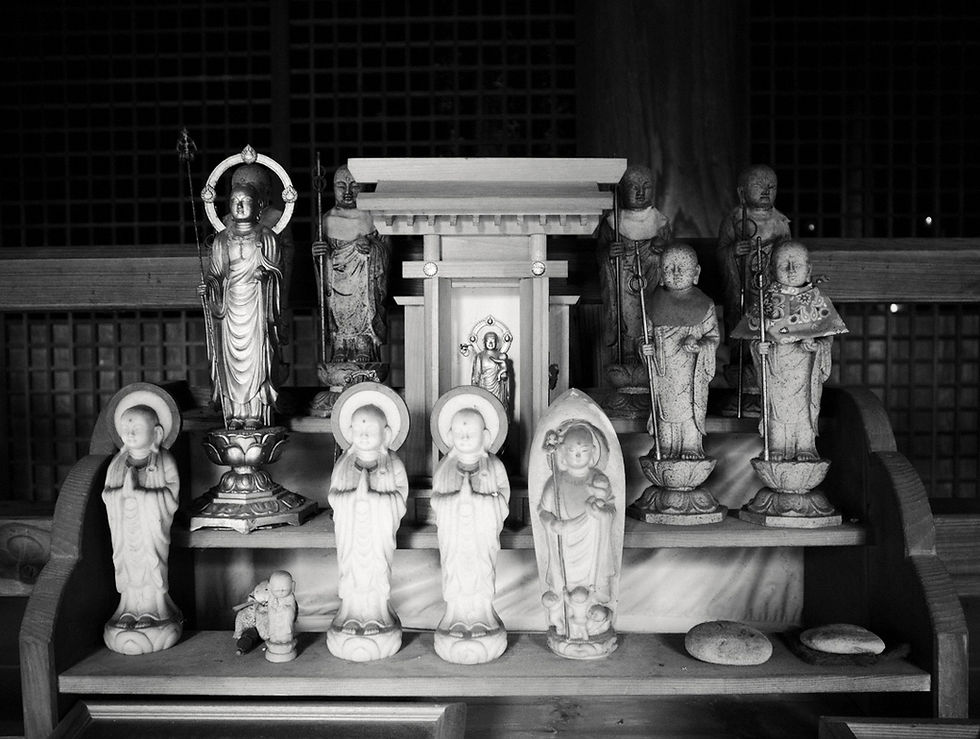
© O. Robert
Meiji Period to Modern Era
With the advent of the Meiji Restoration in 1868, a policy of separating Buddhism and Shintoism, known as Shinbutsu bunri, was implemented, leading to the closure of many temples and the destruction of their assets. However, Engyōji survived this difficult period, although its influence waned over time.
In the modern period that followed, Engyōji regained some prominence, partly due to its unique architectural heritage. The temple was designated as an Important Cultural Property of Japan, and several of its structures, such as the Maniden (摩尼殿) and the Daikōdō (大講堂), are remarkably well-preserved examples of Japanese religious architecture (see below).
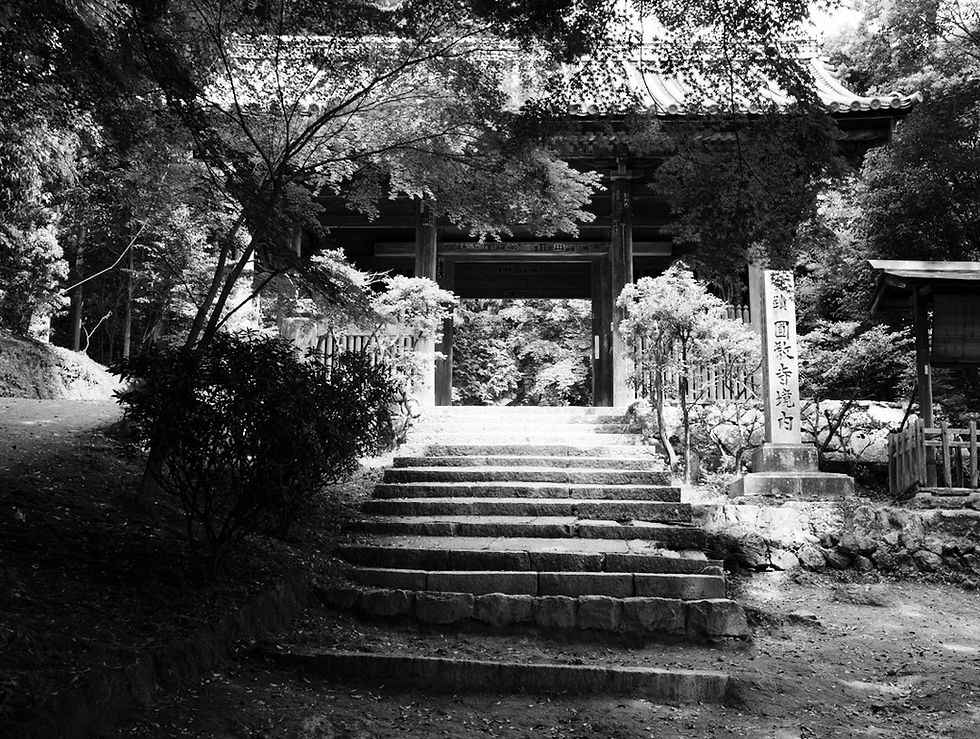
© O. Robert
Characteristics of Engyōji Temple
Engyōji Temple, with its location on Mount Shosha, is distinguished not only by its impressive traditional architecture but also by its geographical setting. Its remarkable features continue to attract pilgrims and tourists from around the world.
Here is an overview of its main characteristics:
Geographical Location
Engyōji Temple is perched on Mount Shosha, at an altitude of about 371 meters. Mount Shosha is located northwest of the famous Himeji Castle, approximately 10 kilometers away.
To reach the temple, visitors can take a cable car from the base of the mountain, followed by a walk through a dense forest. This elevated location, surrounded by nature, contributes to the site's serene and mystical atmosphere, a particularly refreshing visit during the summer heat.
Size and Extent of the Complex
The temple complex covers a vast area spanning several hectares. It consists of numerous buildings and structures scattered throughout Mount Shosha, with over 20 recognized for their cultural heritage value.
Engyōji includes several distinct zones, including the main area with major buildings, secondary pavilions, meditation halls, and hiking trails that connect the different parts of the complex.

© O. Robert
Architecture and Main Structures
Engyōji Temple is characterized by traditional Japanese architecture, typical of Tendai school temples.
Here are the most notable structures of the complex:
Maniden (摩尼殿): The Maniden is one of the most iconic structures at Engyōji. This main hall, dedicated to the goddess Kannon, is built in the Shinden-zukuri style, an aristocratic architectural style from the Heian period.
The hall is elevated on a wooden platform overlooking a valley, offering spectacular views. The current Maniden was rebuilt in 1932 but is based on earlier structures dating from the temple’s founding.
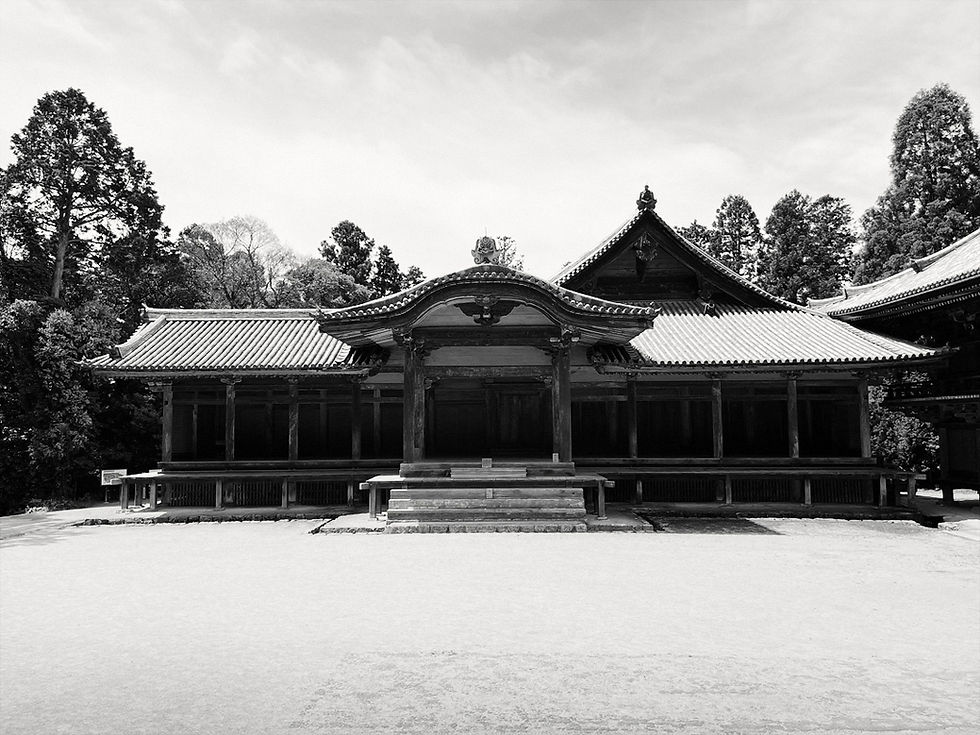
© O. Robert
Daikōdō (大講堂): This building, known as the "Great Hall of Learning," is another key element of the complex. It is used for religious ceremonies and teachings. The Daikōdō is built in the traditional Japanese temple architectural style, featuring a hipped roof covered with tiles, and is surrounded by verandas.
Jōgyōdō (常行堂): The Jōgyōdō is a hall dedicated to meditation and Buddhist practice. It is used for spiritual retreats and long-term meditation exercises known as "Jōgyō."
Jikidō (食堂): This building, once used as a dining hall and dormitory for monks, is one of the oldest structures in the complex. Today, the Jikidō houses a collection of historical artifacts and items related to the temple's history.
Ninnōdō (仁王堂): Located at the entrance of the complex, the Ninnōdō is the hall that houses the famous statues of the two guardians, Agyō and Ungyō, commonly found in significant temples. This hall marks the sacred entrance to the temple and protects the site from malevolent spirits.
Engyōji in Popular Culture
Engyōji Temple has gained prominence in modern popular culture, particularly through its use as a filming location for movies, television series, and even commercials. Its traditional architecture and stunning natural setting make it an ideal location for depicting historical or spiritual scenes in various audiovisual productions.
Here is an overview of some notable works filmed at Engyōji Temple:
The Last Samurai (2003)
The film "The Last Samurai" is arguably the most famous work shot at Engyōji. Directed by Edward Zwick and released in 2003, this film stars Tom Cruise as Nathan Algren, an American army captain who becomes involved in a samurai uprising in Japan at the end of the 19th century.

© O. Robert
In this movie, Engyōji serves as the setting for the village and monastery where Tom Cruise's character is captured and rehabilitated by the samurai, led by their chief, Katsumoto, played by Ken Watanabe.
The Maniden, one of the temple’s main halls, is notably visible in several important scenes. This film has helped bring international attention to Engyōji, turning it into a popular destination not only for movie enthusiasts but also for tourists interested in Japanese culture.
The Time Traveler's Wife (2009)
Another notable work featuring the temple is the television series "The Time Traveler's Wife", aired in 2009. While the use of the temple in this series is more symbolic, the scenes shot at Engyōji add a spiritual and mystical dimension to the story. The serene setting and ancient buildings of the temple are used to represent meditative moments and flashbacks in the characters' pasts.
Rurouni Kenshin (2014)
The movie series "Rurouni Kenshin", inspired by the famous manga of the same name, also used Engyōji as a filming location. In particular, "Rurouni Kenshin: Kyoto Inferno" (2014), the second movie in the series, features scenes shot at Engyōji.

© O. Robert
In this movie, Takeru Satoh, who plays the lead role of Kenshin Himura, a former assassin seeking redemption, is depicted in scenes set in temples and spiritual environments, reflecting the character's inner conflict. The majestic settings of Engyōji add a historical and aesthetic dimension to the character's confrontations with his enemies and his own demons.

© O. Robert
Engyōji, with its authentic atmosphere and natural landscapes, has been used to recreate scenes set in remote Japanese monasteries and villages. The film highlights the spiritual and physical challenges faced by the characters, and the temple adds to the oppressive and contemplative atmosphere of the narrative.
Television Series and Media
Beyond international cinema, Engyōji is frequently used in Japanese historical dramas known as Jidaigeki and various television series. Its authentic setting makes it a prime location for productions aiming to depict feudal Japan or periods of history where spirituality and monastic life were central. These productions help maintain the image of the temple as a place imbued with mysticism and history.
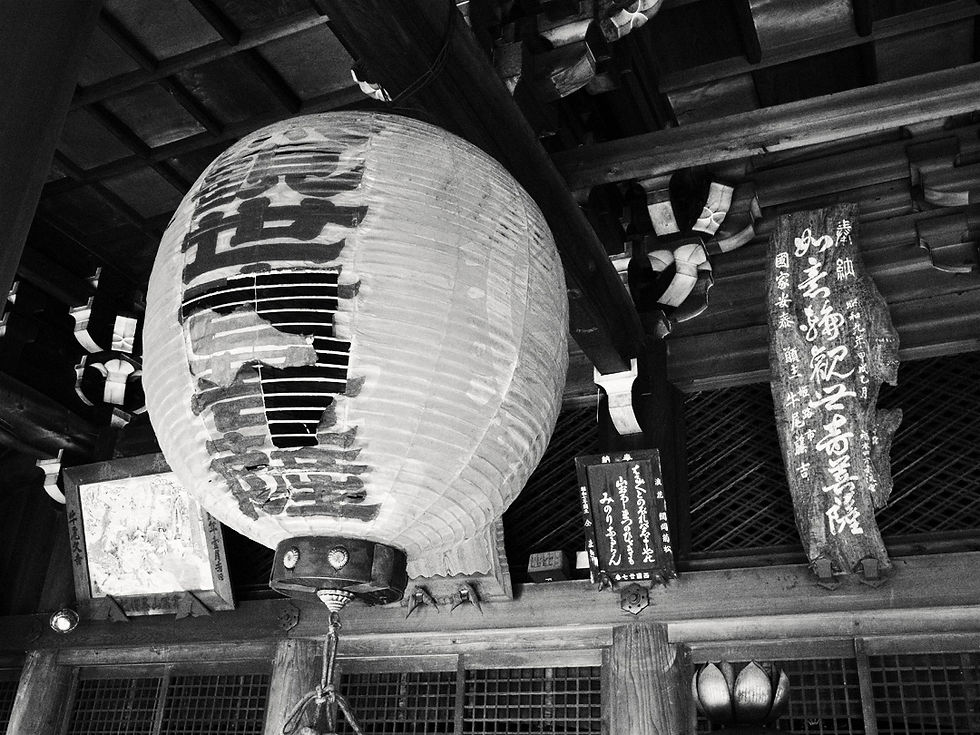
© O. Robert
The Final Word
Engyōji Temple embodies a perfect symbiosis of architecture, nature, and mysticism. Its geographical location, enveloped by dense forest and perched at a height, symbolizes a departure from worldly concerns, an ascent toward the sacred.
This physical and spiritual elevation is reflected in the temple’s architecture, where each building seems to emerge from nature, as a harmonious extension of the mountain. Each structure exudes a serene austerity, a simplicity that contrasts with opulence, encouraging contemplation and introspection.
In monochrome photography, Engyōji reveals a hidden dimension of this relationship between architecture and nature. Capturing Engyōji becomes a mystical practice in itself, an exploration of forms and spaces that portrays the temple as a visual metaphor for inner serenity.












